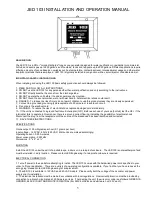
77
TECHNICAL INFORMATION
Emission Control System Information
Source of Emissions
The combustion process produces carbon monoxide, oxides of nitrogen,
and hydrocarbons. Control of hydrocarbons and oxides of nitrogen is
very important because, under certain conditions, they react to form
photochemical smog when subjected to sunlight. Carbon monoxide
does not react in the same way, but it is toxic.
Honda utilizes appropriate air/fuel ratios and other emissions control
systems to reduce the emissions of carbon monoxide, oxides of
nitrogen, and hydrocarbons.
Ignition Timing Control System
The system constantly adjusts the ignition timing, reducing the amount
of HC, CO, and NO
X
produced
.
PGM-FI System
The PGM-FI system uses fuel injection. It has three subsystems: Air
Intake, Engine Control, and Fuel Control. The Generator Control Unit
(GCU) uses various sensors to determine how much air is going into the
engine. It then controls how much fuel to inject under all operating
conditions.
Catalytic Converter
The exhaust system contains a catalytic converter that changes most
of the harmful exhaust gas compounds into harmless compounds.
The U.S. and California Clean Air Acts
EPA and California regulations require all manufacturers to furnish
written instructions describing the operation and maintenance of
emission control systems.
The following instructions and procedures must be followed in order to
keep the emissions from your Honda engine within the emission
standards.
Tampering and Altering
Tampering is a violation of Federal and California law.
Tampering with or altering the emission control system may increase
emissions beyond the legal limit. Among those acts that constitute
tampering are:
• Removal or alteration of any part of intake, fuel, or exhaust systems.
• Alterations that would cause the engine to operate outside its design
parameters.
31Z37613.book 77 ページ 2015年12月2日 水曜日 午前10時45分
















































